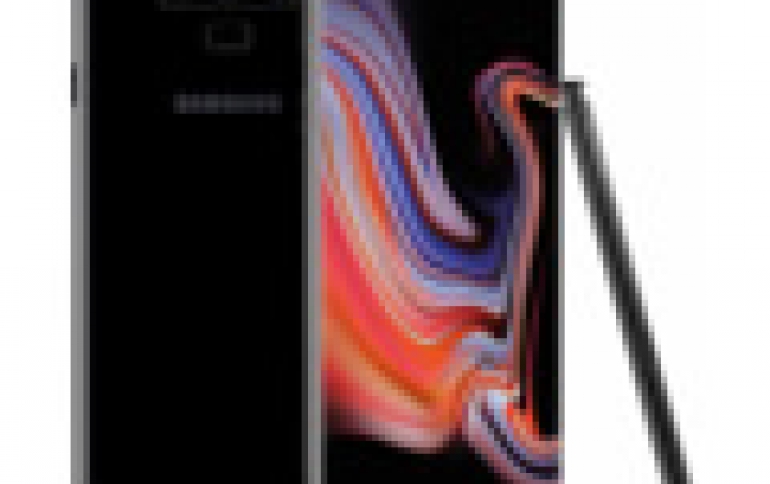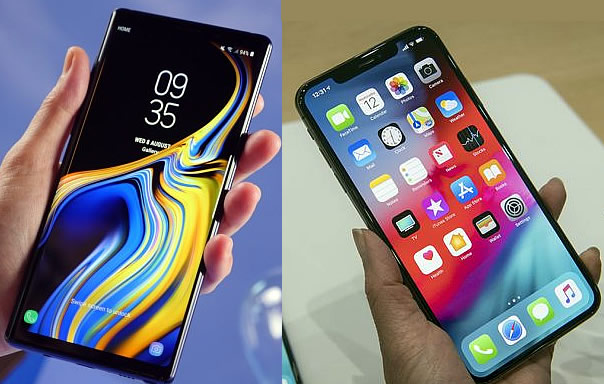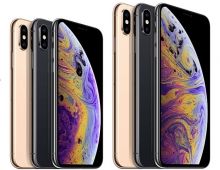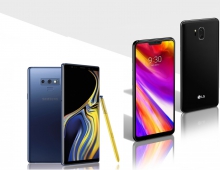
Apple iPhone Xs Max Versus Samsung Galaxy Note 9
Apple on Wednesday introduced its largest-ever smartphone Wednesday, the iPhone Xs Max. With a 6.5-inch screen and prices starting at $1,099, it is competing with the 6.4-inch Samsung Galaxy Note 9.
Compared side-by-side, the two devices obvliously have many similarities but some notable differences are under the hood.
In terms of weight, Samsung's Note 9 is the lighter of the two phones, weighing 201 grams compared to Apple's 208 grams. But the iPhone is about 13 percent thinner, since it lacks a stylus -- the Galaxy Note 9 has room to store the S Pen i its chassis. Speaking of the S Pen, it is actually an importand feature for the Note 9, allowing for handwriting, annotation, and precise navigation around the Note's interface. Apple is only offering such a pen with some iPads.

In addition, the Note 9 does not have any "notch" - the small cut-out that typically huses the front-facing camera and other sensors. Met in many Android devices, it also part of the iPhone Xs Max's design. Such a notch was also featured in the iPhone X.
In terms of displays, each device uses a variation of the same screen technology OLED -- OLED for the iPhone Xs Max and AMOLED for the Note 9. Apple claims the displays offer a 60% improvement in dynamic range compared to the iPhone X. XS Max's display is the largest to appear in an iPhone to date with 3.3 million pixels at 458 ppi (2688x1242). Samsung's 6.4-inch AMOLED has a resolution of 2960x1440, 516ppi.
Apple and Samsung's models both include two camera lenses to the rear one wide-angle, one telephoto - which capture pictures at a resolution of 12 megapixels. The setup lets users take sharp pictures from greater distances, or create the bokeh effect - a blurred background effect. In terms of software, everyone claims that their software and image processing technologies will produce better results. Apple has put some effort into improving the bokeh effect in Portrait Mode and now allows for post-capture adjustment of depth-of-field for stills in the native camera app. A new Smart HDR mode is also available in the new Apple device. When a moving subject is detected, the camera will buffer four frames pre-capture for a "zero shutter lag" effect. An image signal processor works with the device's CPU to analyze scenes and do a better job of isolating Portrait Mode subjects. Apple says the camera captures secondary interframes at different exposures to capture highlight and shadow detail, analyzes the information and merges it into one image.
Biometric security has risen to become a major selling point for smartphones. Samsung has continued to use fingerprint sensors along with options such as iris scanning and facial recognition to secure its devices. But Apple has gone all-in on its Face ID advanced facial-based authentication, and disposed of its Touch ID system and associated hardware button. The iPhone system presents a single solution to biometric security, and the technology has proven itself to be effective and accurate. Apple says the iPhone Xs Max will recognize faces faster that its previous products.
The Note 9 is capabkle of becoming a "PC," although it runs Android. Using a cable, the device can be connected to a monitor and run desktop applications as would be expected on a laptop.
But both Apple and Samsung's flagships contain cutting-edge silicon, with impressive specifications. Apple is using the newly-designed A12 chip, while Samsung uses the Qualcomm Snapdragon 845 SoC. A comparison between the two chips is hard, at least for now, but the vast majority of users will not notice significant differences in speed and computing power.
Samsung's Galaxy Note 9 starts at $1,000, while Apple's iPhone Xs Max will cost $1,099. And of course, higher memory storage capacity options will push these prices even higher. Outside the U.S., the prices are further increased.
In the UK, the iPhone XS Max costs £1,099, £1,249 or £1,449. The numbers are the same as the dollar prices in the U.S., but since the British pound is worth quite a bit more than the dollar, the difference is significant.
For example, the fully tricked out iPhone XS Max costs $1,890 - a staggering $441 difference.
Interestingly, in Singapore, the price for the 512GB iPhone XS Max is 2,349 Singapore dollars or $1711, making the difference only $262. In Australia, the 512GB iPhone XS Max costs 2,369 AUD or $1,703, a $254 difference.
| Samsung Galaxy Note 9 | Apple iPhone XS Max | |
Processor |
|
|
| Display |
|
|
| Splash and water resistance | IP68 | Rated IP68 (maximum depth of 2 meters up to 30 minutes) under IEC standard 60529 |
| Pen support | Yes (Remote Control) | No |
| Cameras | Main camera
Rear Camera
Front Camera
|
|
| Memory |
|
ROM: 64/ 256/ 512 GB |
| Network |
|
Model A1920 FDD-LTE (Bands 1, 2, 3, 4, 5, 7, 8, 12, 13, 14, 17, 18, 19, 20, 25, 26, 29, 30, 32, 66, 71) Model A1921 FDD-LTE (Bands 1, 2, 3, 4, 5, 7, 8, 12, 13, 14, 17, 18, 19, 20, 25, 26, 29, 30, 32, 66, 71) All models Gigabit-class LTE with 4x4 MIMO and LAA4 |
| Connectivity |
|
|
| OS | Android | iOS12 |
| Sensors | Accelerometer, Barometer, Fingerprint Sensor, Gyro Sensor, Geomagnetic Sensor, Hall Sensor, HR Sensor, Iris Sensor, Pressure Sensor, Proximity Sensor, RGB Light Sensor | Face ID
|
| Dimensions | 161.9 x 76.4 x 8.8 mm | 157.5 x 77.4 x 7.7 mm |
| Weight | 201 g | 208 g |
| Battery |
|
|
| Audio and video |
|
|





















